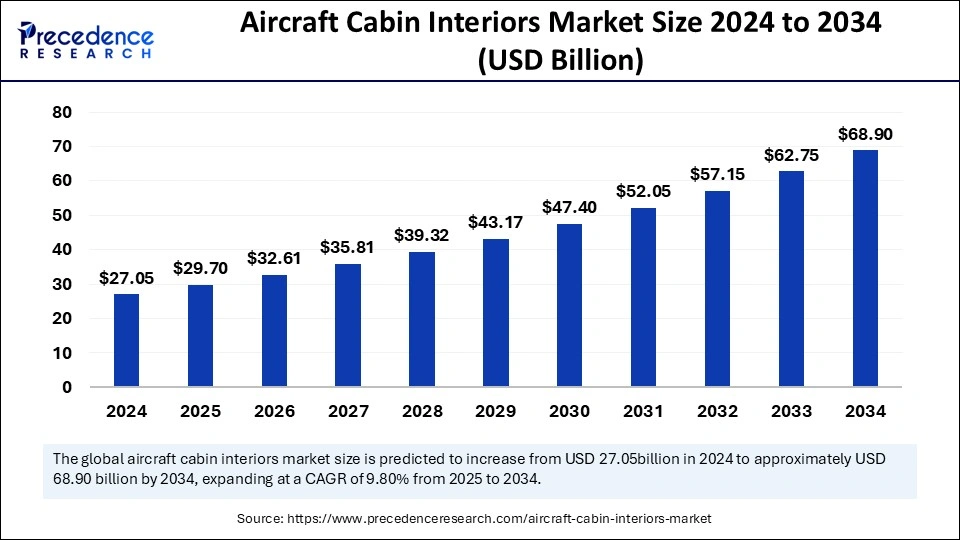
Aircraft Cabin Interiors Market Key Takeaways
- North America dominated the aircraft cabin interiors market with the largest share of 44% in 2024.
- Asia Pacific is expected to grow at the fastest CAGR during the forecast period.
- By type, the in-flight entertainment & connectivity segment held the dominant share of the market in 2024.
- By type, the aircraft galleys segment is expected to grow at the fastest rate between 2025 and 2034.
- By platform, the narrow-body aircraft segment led the market in 2024.
- By platform, the wide-body aircraft segment is anticipated to grow at the highest CAGR over the studied years.
- By material, the alloys segment dominated the global market in 2024.
- By material, the composites segment is projected to expand rapidly in the coming years.
- By end-user, the aftermarket segment dominated the market in 2024.
- By end-user, the OEM segment is expected to grow at the fastest rate during the projection period.
Market Overview
Viewed through the lens of sustainability and material innovation, the aircraft cabin interiors market is undergoing a paradigm shift. Environmental concerns and regulatory pressure are pushing manufacturers and airlines to adopt sustainable materials and energy-efficient systems in cabin design. The goal is to reduce overall carbon footprint without compromising on passenger comfort or safety. This approach spans across new aircraft interiors and retrofit programs.
Drivers
The primary drivers in this segment include rising environmental awareness, the aviation industry’s net-zero emissions targets, and consumer preference for sustainable travel options. Airlines are actively seeking lighter, recyclable materials to lower fuel consumption and emissions. Regulatory mandates from aviation authorities and environmental agencies are also accelerating the transition toward green cabin interiors.
Opportunities
Innovation in bio-based and recyclable materials presents significant opportunities. Lightweight composites, 3D-printed components, and modular systems that reduce material waste are gaining traction. There is also an increasing push for cabins with smart lighting and energy-efficient systems, which can significantly improve sustainability metrics. Certification pathways for sustainable materials are opening new commercial possibilities for green-tech startups and established manufacturers alike.
Challenges
The biggest challenge is ensuring that sustainable materials meet the stringent flammability, durability, and safety standards required in aviation. High development costs and limited supply chain maturity for sustainable alternatives also slow down widespread adoption. Furthermore, balancing sustainability with luxury in premium cabins requires innovative design thinking and technological investments.
Regional Insights
Europe is at the forefront of sustainable aviation interior development, with strong policy backing from the European Union. North America is rapidly catching up, particularly in response to pressure from eco-conscious consumers and sustainability targets set by major airlines. In Asia-Pacific, countries like Japan and Singapore are investing in green aviation technologies, including cabin materials. Middle Eastern carriers are also showing interest in sustainable luxury as part of broader environmental commitments.
Recent Developments
Recent developments include the launch of eco-friendly cabin concepts by major OEMs, featuring bamboo flooring, recycled textiles, and lightweight alloys. Companies are experimenting with bioplastics, natural fiber composites, and closed-loop recycling systems for cabin components. Collaborative industry initiatives are being launched to standardize sustainability metrics and accelerate the certification of new materials.
Aircraft Cabin Interiors Market Companies
- The Boeing Company
- Thales Group
- Panasonic Corporation
- JCB Aero
- Hong Kong Aircraft Engineering Company Limited
- Honeywell International Inc.
- Gogo, Inc
- Collins Aerospace
- Cobham PLC
- Astronics Corporation
Segments Covered in the Report:
By Type
- In-flight Entertainment & Connectivity
- Aircraft Seating
- Aircraft Galleys
- Aircraft Cabin Lighting
- Aircraft Lavatories
- Aircraft Windows & Windshields
- Aircraft Storage Bins
- Aircraft Interior Panels
By Platform
- Narrow-body Aircraft
- Regional Transport Aircraft
- Wide-body Aircraft
- Business Jet
By Material
- Composites
- alloys
- Others
By End-user
- MRO
- Aftermarket
- OEM
By Region
- North America
- Europe
- Asia Pacific
- Latin America
- Middle East and Africa
